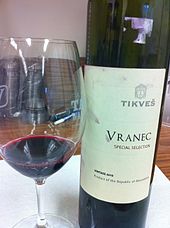Macedonian wine
This article will address the topic of Macedonian wine, which has been the object of interest and study by various disciplines over time. Macedonian wine has exerted a significant influence on different aspects of society, culture and history, leaving its mark on people's lives and the development of communities. Through a detailed analysis, the different dimensions and perspectives surrounding Macedonian wine will be explored, offering the reader a comprehensive and enriching vision of this topic that is so relevant today. By compiling research, testimonies and expert opinions, the aim is to contribute to the knowledge and understanding of Macedonian wine, providing the reader with the necessary tools to reflect and form their own judgment on the matter.

North Macedonia produces wine on some 22,400 hectares (55,000 acres) of vineyards, and the production was 108,100 tonnes in 2008. There are also some additional 30,000 hectares (74,000 acres) of vineyards dedicated to table grapes. Red wine dominates the Macedonian wine production, with around 80 per cent.[citation needed]
In contrast, within the European Union, "Macedonia" is a protected geographical indication (PGI) for wines produced in the Greek viticulture region of Macedonia.
History
While part of Yugoslavia, Macedonia was a producer of wine and mastika. In the 1980s, it accounted for around two-thirds of the Yugoslav wine production. After the breakup of Yugoslavia, the wine production of the new country decreased dramatically, from 1.8 million hectoliters in the mid-1990s to 447,000 hl in 2002.
Wine regions

North Macedonia has three wine-growing regions:
- Povardarie, in the valley of river Vardar, mostly around the towns of Negotino and Kavadarci. It is the most important region both in terms of quantity and wine quality.
- Pčinja-Osogovo, to the east on the border with Bulgaria.
- Pelagonija-Polog, around Lake Ohrid, to the west on the border with Albania.
Grape varieties
The grape varieties common in cultivation includes a large proportion of indigenous varieties and varieties common to Central Europe and the Balkans, as well as some international varieties. Red varieties include Vranec (the most common variety of North Macedonia), Kratosija, Cabernet Sauvignon and Merlot. Stanušina Crna is a unique variety of grape of local origin from North Macedonia, capable of producing very high quality wines, very popular on domestic market, little known outside its native country. White varieties include Smederevka, Welschriesling (usually referred to as Laški Rizling), Chardonnay, Sauvignon blanc and Žilavka.
References
- ^ a b c d Jancis Robinson, ed. (2006). "Macedonia". Oxford Companion to Wine (3rd ed.). Oxford: Oxford University Press. pp. 414. ISBN 0-19-860990-6.
- ^ "Wine production (tons)". Food and Agriculture Organization. p. 28. Archived from the original on 20 May 2011. Retrieved 11 February 2011.
- ^ e-bacchus: Μακεδονία
